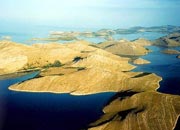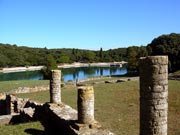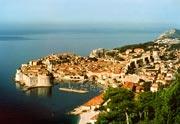
Croatia is a beautiful small country on the Adriatic coast. It is known as the country of a thousand islands. If you have ever dreamt about being on a small island alone with someone, this is the place for you.
If you are a nature lover, Croatia offers camping, mountain hiking/biking, rafting, scuba diving and skydiving. Besides its natural beauty, it also offers a unique history, a unique mixture of cuisines, many internationally recognized hotels and helpful individuals.
In Croatia, where the Mediterranean, the mountains and the Pannonian plains come together in a unique harmony of natural beauty, within just a little more than a hundred kilometres, you can come across excitingly different landscapes.
 Croatia is undoubtedly such a popular travel destination mostly because of the Adriatic, with one of the most beautiful coasts in the world with its 1,185 islands and islets, of which only 66 are inhabited. Continental Croatia, however, also abounds in beauty. It is a land of golden wheat fields, oak woods and wide rivers of Slavonia and Baranja, a land of quaint little villages, romantic castles and manors, and picturesque rolling hills and vineyards of the Croatian Zagorje. It is a land of forests, rivers rich in fish, swift mountain streams and deep gorges of Gorski Kotar, and the magnificent Plitvice Lakes in Lika. Plitvice is Croatia's most famous National Park. It has many lakes and waterfalls and is ideal for hiking or trekking. Croatia is undoubtedly such a popular travel destination mostly because of the Adriatic, with one of the most beautiful coasts in the world with its 1,185 islands and islets, of which only 66 are inhabited. Continental Croatia, however, also abounds in beauty. It is a land of golden wheat fields, oak woods and wide rivers of Slavonia and Baranja, a land of quaint little villages, romantic castles and manors, and picturesque rolling hills and vineyards of the Croatian Zagorje. It is a land of forests, rivers rich in fish, swift mountain streams and deep gorges of Gorski Kotar, and the magnificent Plitvice Lakes in Lika. Plitvice is Croatia's most famous National Park. It has many lakes and waterfalls and is ideal for hiking or trekking.
 Zagreb is a vivacious new European metropolis that has well preserved its Central European charm, the capital city of Croatia and the country's political, economic, intellectual and cultural centre. Zagreb is a vivacious new European metropolis that has well preserved its Central European charm, the capital city of Croatia and the country's political, economic, intellectual and cultural centre.
Further down south, region Dalmatia is beautiful with untouchable nature and thousand islands. Dalmatia, is the apogee of the Mediterranean, bursting with colours, fragrances and shapes, unforgettable in the intensity of the experience of nature. It is a region of long beaches, pine woods and the ancient towns of Zadar, Sibenik, Split, Trogir, Omis and Dubrovnik, that testify to the rich cultural and historical heritage of Croatia. The islands of Hvar, Brac, Solta, Korcula, Vis, Mljet and others, although equally enchanting, are all unique in their character. Dalmatia is also known for its good wines and friendly people. Island Ciovo is only 25 km far away from Split and is connected with bridge to Trogir a litlle town under protection of UNESCO. You should visit this phantastic town because many celebrity were there (Bernie Ecclestione, Albert Grinaldi, Gwyneth Palthrow, Armani and many others).
The most popular possibilities for travel and tourism, of course, is summer tourism. You can also enjoy the benefits of rural tourism in many of the villages in the continental region of Croatia, as well as of health tourism in a number of spas and thermal and mineral springs, such as Varazdinske, Tuheljske, Stubicke and Krapinske spas, Lipik, Daruvar or Topusko in the continental region, and along the coast: Losinj, Umag, Opatija, Crikvenica, Hvar, Makarska, Vela Luka and Istarske Spa in Istria.
Istria is the most developed Croatian tourist region, closest and most easily accessible from Western Europe, whose landscape can be compared to that of Tuscany or Provence. The first know inhabitants of  Istria were the Histri, from whom Istria received its name. Numerous peoples and cultures, from Romantimes to today, have left evidence of their cultures in the architecture, wall painting and in the rich church architecture. Vineyards and picturesque little towns are scattered all over the interior of the peninsula. Istria were the Histri, from whom Istria received its name. Numerous peoples and cultures, from Romantimes to today, have left evidence of their cultures in the architecture, wall painting and in the rich church architecture. Vineyards and picturesque little towns are scattered all over the interior of the peninsula.
The Brijuni Archipelago consists of two large and twelve smaller islands off the west coast of Istria. The archipelago is one of the seven National Parks of Croatia, abounding in rare plant and animal species, including a zoo park with animals from other climate zones. Some extraordinary examples of Roman and Byzantine heritage can be found on the islands.
Split is the second largest city in Croatia, and the regional capital of Dalmatia, built inside and around the historical Diocletian's Palace from the third century, included in the UNESCO world heritage list. The people of Split, who are particularly attached to their city and the hill called Marjan overlooking it, will proudly boast that there is no other place in the world like Split.
 Dubrovnik, a medieval aristocratic republic from the 12th-19th centuries and the best preserved walled city in the Mediterranean, is one of Croatia's main tourist attractions and one of only three European cities ranked as a World Heritage Site of zero category by UNESCO, which the English poet Lord Byron named the "pearl of the Adriatic". The enchanting landscape, including the nearby islands, the beeches, the numberless historical sites, the colours, the shapes, the scents, the warmth of the climate and people... will all provide for an unforgettable experience. Dubrovnik, a medieval aristocratic republic from the 12th-19th centuries and the best preserved walled city in the Mediterranean, is one of Croatia's main tourist attractions and one of only three European cities ranked as a World Heritage Site of zero category by UNESCO, which the English poet Lord Byron named the "pearl of the Adriatic". The enchanting landscape, including the nearby islands, the beeches, the numberless historical sites, the colours, the shapes, the scents, the warmth of the climate and people... will all provide for an unforgettable experience.
There are manny beautiful islands in Croatia, like Korcula, the birthplace of Marco Polo, Hvar, Brac, which has one of the most beautiful beaches in the Mediterranean - Zlatni rat - which is also a windsurfing paradise. The island of Mljet which is situated between the island of Korcula and Dubrovnik. The most visited island is Krk, but in the Kvarner there are also Cres, Losinj, Rab, Pag... To mention only most famous.
With 1778km (1111 miles) of mainland coast, emerald-blue waters, secluded pebble beaches and countless unspoilt islands, Croatia is an ideal destination for those who want to avoid the crowds and to enjoy the sea and the sunshine.
We invite you to discover and enjoy the beauties of Croatia, its mild climate, the crystal clean, warm sea water, beautiful beaches, virgin nature, combined with rich history and cultural heritage, delicious cuisine and good wines, an above all, warm and friendly people.
Croatia facts
top of the site
|